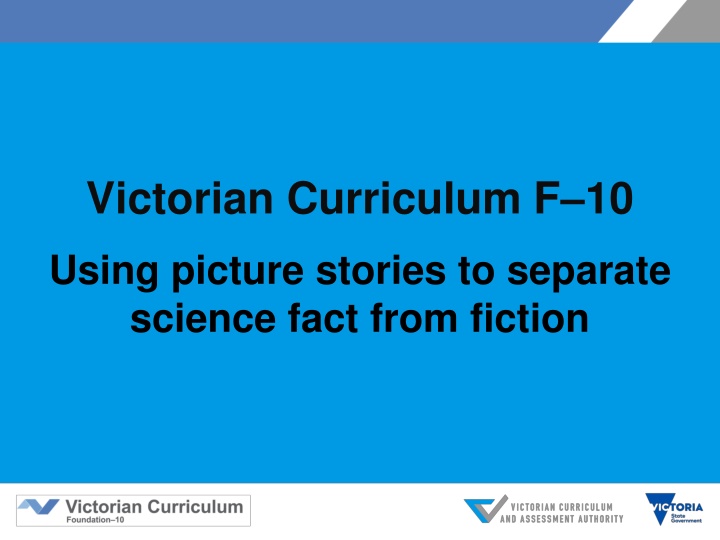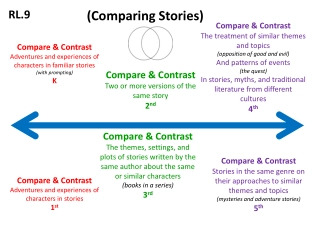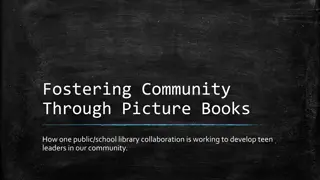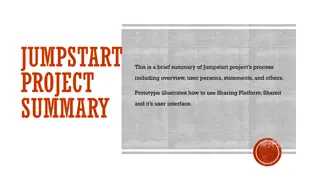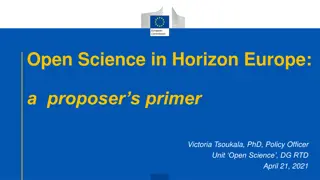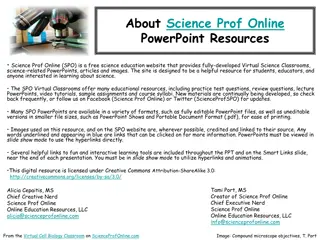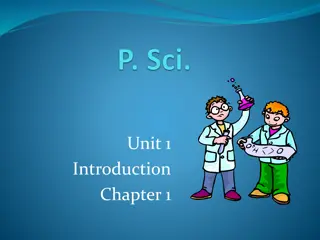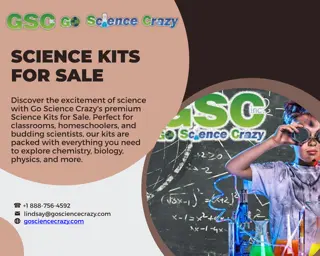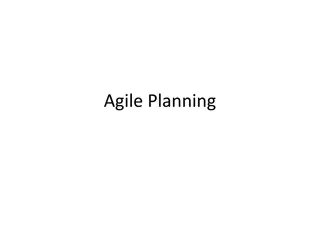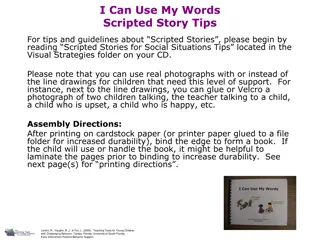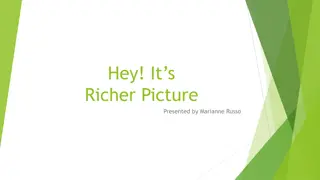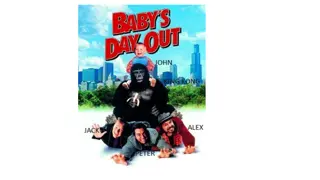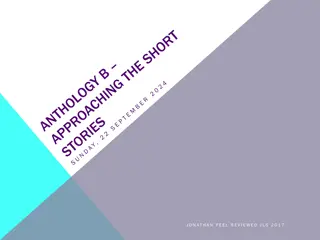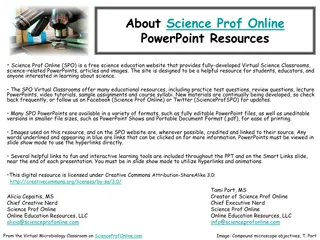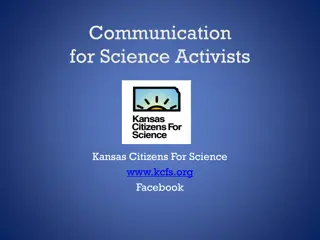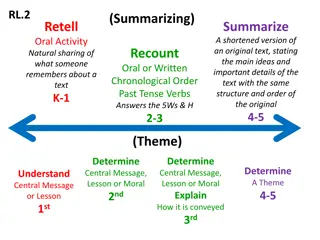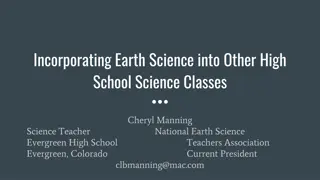Enhancing Science Understanding Through Picture Stories
Explore how using picture stories can help students in the Victorian Curriculum F-10 to differentiate between science fact and fiction. The curriculum emphasizes the importance of discipline-based learning and provides a continuum of knowledge and skills essential for lifelong learning and social development. Discover how picture stories support science inquiry skills and how science can be integrated effectively with other teaching programs. Gain insights into the curriculum design and structure that focus on enduring and dynamic capabilities, transferable knowledge, and explicit instruction for enhanced learning outcomes.
Download Presentation

Please find below an Image/Link to download the presentation.
The content on the website is provided AS IS for your information and personal use only. It may not be sold, licensed, or shared on other websites without obtaining consent from the author.If you encounter any issues during the download, it is possible that the publisher has removed the file from their server.
You are allowed to download the files provided on this website for personal or commercial use, subject to the condition that they are used lawfully. All files are the property of their respective owners.
The content on the website is provided AS IS for your information and personal use only. It may not be sold, licensed, or shared on other websites without obtaining consent from the author.
E N D
Presentation Transcript
Victorian Curriculum F10 Using picture stories to separate science fact from fiction
Agenda How can picture stories support science understanding and science inquiry skills? How can science be supported through other teaching and learning programs?
Victorian Curriculum F-10 describes a common set of knowledge and skills required by all students for lifelong learning, social development and active and informed citizens is represented as a continuum of learning or set of progressions defining increasingly complex knowledge, skills and concepts
Victorian Curriculum Design and Structure Design and structure reaffirms: the importance of discipline-based learning approach, where the disciplines are regarded as both enduring and dynamic capabilities are a set of discrete knowledge and skills, not a statement of pedagogies and students benefit from explicit instruction that knowledge and skills are transferrable across the curriculum and therefore are not duplicated. http://victoriancurriculum.vcaa.vic.edu.au/overview/curriculum- design/learning-areas-and-capabilities
Terminology Term Explanation Level/Band descriptions Strands Statements that provide an overview to the content descriptions and achievement standard within the level or band. Key organising elements within each curriculum area. Supplementary organising elements within some curriculum areas. Specific and discrete information identifying what teachers are expected to teach and students are expected to learn. Non-mandated, advisory examples that provide guidance on how the curriculum may be transformed into a classroom activity or learning opportunity. Statements that describe what students are typically able to understand and do, and are the basis for reporting student achievement. Sub-strands Content descriptions Elaborations Achievement standards
Curriculum Planning Based on the content descriptions and achievement standards http://www.vcaa.vic.edu.au/Pages/foundation10/viccurriculum/curriculumplanning.aspx
Curriculum Planning School decision http://www.vcaa.vic.edu.au/Pages/foundation10/viccurriculum/curriculumplanning.aspx
Cross-curriculum Priorities Aboriginal and Torres Strait Islander histories and cultures Asia and Australia s engagement with Asia Sustainability Embedded in the Victorian Curriculum F 10, it is not another curriculum. Mapping documents supplied
How is Science Education delivered in schools? In many different ways! Most schools for F-6 do not have specialist teachers for Science, so it is important for all teachers to be able to provide opportunities for their students to experience learning in science.
Supporting learning The most important single factor influencing learning is what the learner already knows. Ascertain this and teach him accordingly (Ausubel 1968) Vygotsky (1978) referred to the zone of proximal development the region of just manageable difficulties where students can succeed but often only with the support of others for example through scaffolding activities. learning is enhanced when teachers pay attention to the knowledge and beliefs that learners bring to the learning task and use this knowledge as a starting point for new instruction (Bransford et al 2000)
Why is curriculum planning so important? A guaranteed and viable curriculum is the school level factor that has the most impact on student achievement A guaranteed and viable curriculum is defined as a combination of opportunity to learn and time to learn (What works in schools: Translating research into action Marzano 2003) It is not enough for a curriculum to be implicit, it must be explicit and it must be coherent Effective planning and documentation is a significant part of providing a guaranteed and viable curriculum
Curriculum planning - a unit of work http://curriculumplanning.vcaa.vic.edu.au/sat/self-assessment-tool
Looking for opportunities to support and extend student learning SOLO Taxonomy (Biggs and Collis, 1982) Prestructural Unistructural Multistructural Relational Extended abstract
Picture stories that support student learning Look for stories that contain opportunities to integrate science into literacy/inquiry units Look for stories that will hook/engage students into science concepts Look for stories that allow differentiation of student understanding unistructural, multistructural, relational, extended abstract
Sun by Sam Usher Also in the series Rain, Snow hottest day of the year hotter than broccoli soup hotter than the Atacama Desert hotter than the surface of the sun The sun beat down Grandad navigated I hope it s sunny again tomorrow
Sun by Sam Usher Science F-2 Science Understanding Observable changes occur in the sky and landscape; daily and seasonal changes affect everyday life Earth s rotation on its axis causes regular changes, including night and day Earth is part of a system of planets orbiting around a star (the Sun) 3-4 5-6 English Language Literature Literacy Text structure and organisation Examining literature, responding to literature Texts in context, creating texts
Where does Thursday go? Janeen Brian, Stephen Michael King It was Thursday What happened to it during the night? Where does Thursday go before Friday comes? Toowhit! Toowhoo! called an own from a tall tree cool night air There was the moon big and round and bright the moon began to drift slowly behind a cloud the sun brought Friday
Where does Thursday go? Janeen Brian, Stephen Michael King Science F-2 Science Understanding Observable changes occur in the sky and landscape; daily and seasonal changes affect everyday life Earth s rotation on its axis causes regular changes, including night and day Earth is part of a system of planets orbiting around a star (the Sun) 3-4 5-6 English Language Literature Literacy Text structure and organisation Examining literature, responding to literature Texts in context, creating texts
The GruffalosChild Julia Donaldson, Axel Scheffler Out came the moon. It was bright and round. A terrible shadow fell onto the ground Science 5-6 Science Understanding Light from a source forms shadows and can be absorbed, reflected and refracted English Language Literature Literacy Text structure and organisation Examining literature, responding to literature Texts in context, creating texts
Carmichaels Journey Shelly Fussell, Samantha Metcalfe Carmichael the Carnaby s Black Cockatoo has made his first flight out of the next and joined his parents on the long journey to their coastal feeding grounds. But when they return, they find their home has been destroyed. What will they do? And, more importantly, what can we all do to help?
Carmichaels Journey Shelly Fussell, Samantha Metcalfe Science F-2 Science Understanding Living things grow, change and have offspring similar to themselves Different living things have different life cycles and depend on each other and the environment to survive The growth and survival of living things are affect by the physical conditions of their environment Interactions between organisms can be described in terms of food chains and food webs and can be affected by human activity 3-4 5-6 7-8 Cross-curricular priorities Sustainability
Home for Bilby Joanne Crawford, Grace Fielding Science 3-4 Science Understanding Different living things have different life cycles and depend on each other and the environment to survive Living things can be grouped on the basis of observable features and can be distinguished from non-living things The growth and survival of living things are affect by the physical conditions of their environment Interactions between organisms can be described in terms of food chains and food webs and can be affected by human activity Cross-curricular priorities Sustainability Aboriginal and Torres Strait Islander histories and cultures 3-4 5-6 7-8
The Very Hungry Caterpillar Eric Carle In the light of the moon, a little egg lay on a leaf One Sunday morning the warm sun came up On Monday, On Tuesday ..The next day was Sunday again That night he had a stomachache! The caterpillar ate through one nice green leaf, and after than he felt much better He build a small house, called a cocoon He stayed inside for more than two weeks He was a beautiful butterfly
The Very Hungry Caterpillar Erin Carle Science F-2 Science Understanding Living things grow, change and have offspring similar to themselves Different living things have different life cycles and depend on each other and the environment to survive The growth and survival of living things are affect by the physical conditions of their environment Interactions between organisms can be described in terms of food chains and food webs and can be affected by human activity 3-4 5-6 7-8
Chip Kylie Howarth Chip, like most other gulls, was wild about fish and chips Chips were ALL Chip could think about even thought they made his tummy ache Do not feed the gulls And every evening the gulls would gulp a tummy- full of Joe s fresh fish. (Which were better than chips any day!)
Chip Kylie Howarth Science F-2 Science Understanding Living things grow, change and have offspring similar to themselves Different living things have different life cycles and depend on each other and the environment to survive The growth and survival of living things are affect by the physical conditions of their environment Interactions between organisms can be described in terms of food chains and food webs and can be affected by human activity 3-4 5-6 7-8
Chip Kylie Howarth English Language Literature Literacy Text structure and organisation Examining literature, responding to literature Texts in context, creating texts
Diary of a Wombat Jackie French, Bruce Whatley Days of the week Morning: Slept, Afternoon: Slept, Evening: Ate grass, Night: Ate grass Demanded a carrot, the carrot was delish Chewed hole in door Demanded rolled oats instead Animals as anthropomorphic
Diary of a Wombat Jackie French, Bruce Whatley Science F-2 Science Understanding Living things grow, change and have offspring similar to themselves Different living things have different life cycles and depend on each other and the environment to survive The growth and survival of living things are affect by the physical conditions of their environment Interactions between organisms can be described in terms of food chains and food webs and can be affected by human activity 3-4 5-6 7-8
Diary of a Wombat Jackie French, Bruce Whatley English Language Literature Literacy Text structure and organisation Examining literature, responding to literature Texts in context, creating texts
The Worm Elise Gravel Disgusting Critters series Science 5-6 Science Understanding Living things have structural features and adaptations that help them survive in their environment The growth and survival of living things are affect by the physical conditions of their environment There are differences within and between groups of organisms; classification helps organise this diversity Interactions between organisms can be described in terms of food chains and food webs and can be affected by human activity 5-6 7-8 7-8
The Worm Elise Gravel English Language Literature Literacy Text structure and organisation Examining literature, responding to literature Texts in context, creating texts
Ernie Dances to the Didgeridoo Alison Lester Kudjewk (goo-jawk): Monsoon Season (December to March) Bangkerreng (bung-ge-reng): harvest time, March to May Yekke (yek-ge): cool weather, May to June Wurrkeng (whirr (rr is rolled) roong): early dry season, August to October Kurrung (gurr (rr is rolled) roong): hot and dry, August to October Kurnumeleng(goo-noo-meleng): pre-monsoon season, October to December
Ernie Dances to the Didgeridoo Alison Lester Science Science Understanding F-2 Observable changes occur in the sky and landscape; daily and seasonal changes affect everyday life 3-4 Earth s rotation on its axis causes regular changes, including night and day 5-6 Earth is part of a system of planets orbiting around a star (the Sun)
Ernie Dances to the Didgeridoo Alison Lester Science 3-4 Science Understanding Different living things have different life cycles and depend on each other and the environment to survive Living things can be grouped on the basis of observable features and can be distinguished from non-living things The growth and survival of living things are affect by the physical conditions of their environment Interactions between organisms can be described in terms of food chains and food webs and can be affected by human activity 3-4 5-6 7-8
Ernie Dances to the Didgeridoo Alison Lester Cross-curricular priorities Sustainability Aboriginal and Torres Strait Islander histories and cultures English Language Literature Literacy Text structure and organisation Examining literature, responding to literature Texts in context, creating texts
Ernie Dances to the Didgeridoo Alison Lester Supporting Resources https://www.visitvictoria.com/things-to-do/aboriginal- victoria/aboriginal-seasons-of-victoria https://parksaustralia.gov.au/kakadu/discover/nature/seasons/ Additional Texts Walking With the Seasons in Kakadu By: Diane Lucas, Ken Searle (Illustrator)
Tree Britta Teckentrup Seasons come, seasons go In the forest, all is still,gripped by winter s icy chill Snow is melting all around, shoots are peeping through the ground. In the trees, young bear cubs play, Spring cannot be far away Now summer s here, the sun is high, Bees are humming in the sky. Juicy apples, ripe and sweet, Almost ready for you to eat.
Tree Britta Teckentrup Science F-2 Science Understanding Observable changes occur in the sky and landscape; daily and seasonal changes affect everyday life Earth s rotation on its axis causes regular changes, including night and day Earth is part of a system of planets orbiting around a star (the Sun) 3-4 5-6
Tree Britta Teckentrup Science 3-4 Science Understanding Different living things have different life cycles and depend on each other and the environment to survive Living things can be grouped on the basis of observable features and can be distinguished from non-living things The growth and survival of living things are affect by the physical conditions of their environment Interactions between organisms can be described in terms of food chains and food webs and can be affected by human activity 3-4 5-6 7-8
A Year on our Farm Penny Matthews and Andrew McLean Summer, Autumn, Winter, Spring from a southern- hemisphere perspective Science F-2 Science Understanding Observable changes occur in the sky and landscape; daily and seasonal changes affect everyday life Earth s rotation on its axis causes regular changes, including night and day Earth is part of a system of planets orbiting around a star (the Sun) 3-4 5-6
A Year on our Farm Penny Matthews and Andrew McLean Science 3-4 Science Understanding Different living things have different life cycles and depend on each other and the environment to survive Living things can be grouped on the basis of observable features and can be distinguished from non-living things The growth and survival of living things are affect by the physical conditions of their environment Interactions between organisms can be described in terms of food chains and food webs and can be affected by human activity 3-4 5-6 7-8
Other picture books for inspiration A Patch from Scratch: Megan Forward My Farm: Alison Lester Sleep Tight Farm: Eugenie Doyle & Becca Stadlander Look at the Weather: Britta Teckentrup The ABC Books of Seasons: Helen Martin, Judith Simpson & Cheryl Orsini Secrets of the Rainforest: Carron Brown & Alyssa Nassner
Other picture books for inspiration The Hidden Rainforest: Jeannie Baker Crocodile River: Diana Lawrenson & Danny Snell Backyard: Ananda Braxton-Smith & Lizzy Newcomb The Lorax: Dr Seuss Where the forest meets the sea: Jeannie Baker The Story of Rosy Dock: Jeannie Baker What s Hidden in the Woods? : Aina Bestard Rainbow Bear: Stephen Michael King
Other picture books for inspiration Over and Under the Snow: Kate Messner (eBook) Up in the Garden and Down in the Dirt: Kate Messner (eBook) Over and Under the Pond: Kate Messner (eBook) AND LOTS, LOTS MORE!
Contact Erin Wilson Curriculum Manager, STEM 03 9032 1723 wilson.erin.c@edumail.vic.gov.au
